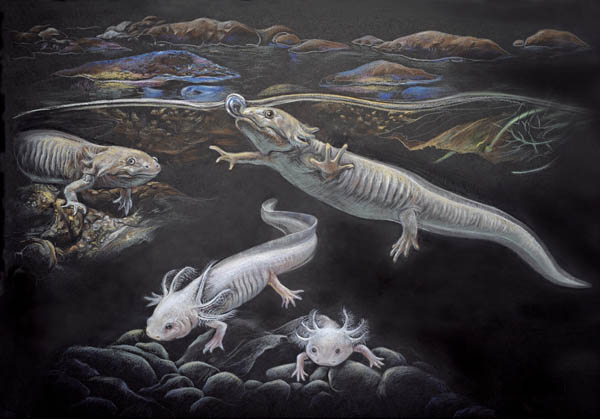Regalerpeton weichangensis is a type of tailed amphibian from the Early Cretaceous in Weichang, Hebei Province. Recently, the research team of researcher Wang Yuan from the Institute of Vertebrate Paleontology conducted research on 8 newly discovered fossil materials, and revised and supplemented the identification characteristics of the Paddock royal salamander. Relevant research results were published in Vertebrata PalAsiatica.
New research points out that pairs of parallel ossified hypobranchial bones I and II only appear in larvae and juvenile salamanders, so they are also considered to be juvenile lingual branchial organs. The adult Paddock royal salamander preserves three pairs of external gills, juvenile wing bones, and juvenile lingual gill apparatus. These characteristics indicate that Royal salamander should be a juvenile salamander.
Restore the ecological environment of the royal salamander based on morphological characteristics: young individuals of the royal salamander retain three pairs of external gills, with dense gill filaments and a high tail fin. They live in relatively deep waters and rely on their gills to breathe. During the transition to adulthood, the external gills degenerate and the tail fin is reduced. It lives in shallow waters and can put its head out of the water to breathe through its mouth. In addition, fossil records show that adult Paddock royal salamanders preserved ossified carpotarsal bones, indicating that their limbs had strong support capabilities.
This project was funded by the National Natural Science Foundation of China (Grant No. 41472018) and the Strategic Priority Science and Technology Project of the Chinese Academy of Sciences (No. XDB18030503).

Figure 1 Dorsal view of the royal salamander in the enclosure (Photo provided by Rong Yufen)

Figure 2 Ecological restoration map of the royal salamander in the paddock (drawn by Guo Xiaocong)
animal tags: anurans amphibians salamander fossil evolution
We created this article in conjunction with AI technology, then made sure it was fact-checked and edited by a Animals Top editor.